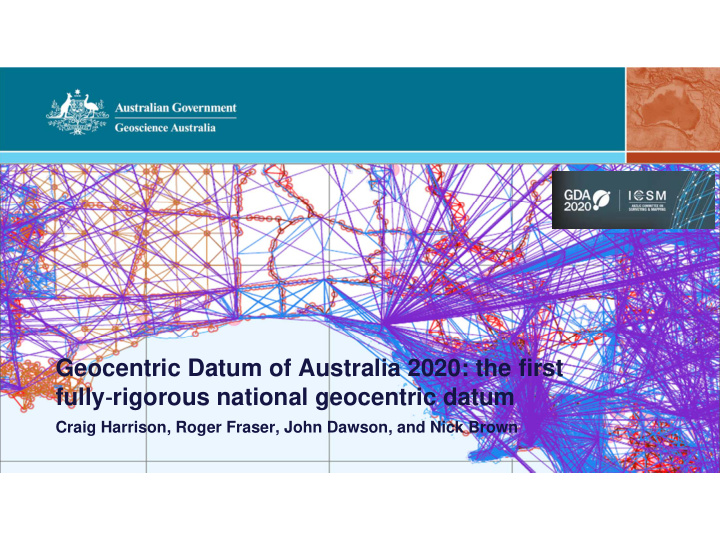



Geocentric Datum of Australia 2020: the first fully ‐ rigorous national geocentric datum Craig Harrison, Roger Fraser, John Dawson, and Nick Brown
Collaborators • GA : John Dawson*, Nick Brown*, GNSS Analysis Team, GNSS Operations Team • Defence : Zarina Jayaswal* • ACT : Gavin Evans^ • NSW : Simon McElroy*, Joel Haasdyk^, Nic Gowans^ • Victoria : Roger Fraser^ & Alex Woods • Tasmania : Scott Strong^ • SA : Steve Turner*, Andrew Falkenberg*, Stephen Latham, Malcolm Driver • WA : Linda Morgan^, Kent Wheeler^, Irek Baran, Rod Stone • NT : Rob Sarib*, Amy Peterson^, Mathew Fraser • Queensland : Matt Higgins*, Darren Burns*, Steve Tarbit, Peter Todd • UNSW : Chris Rizos* • RMIT : Don Grant* (AWG members, * PCG members, ^ both) IGNSS 2018, UNSW – 8 February
Improvements over GDA94 • Truly national adjustment • The ability to automatically segment the network is a world first • 3D adjustment (Earth-centred Cartesian reference frame) • Rigorous uncertainties in accordance with SP1 • Positional uncertainties • Relative uncertainties • 1 January 2020 reference epoch • Distortion free IGNSS 2018, UNSW – 8 February
Input data sets • Asia-Pacific Reference Frame (APREF) • 454-station GNSS point cluster • Constrains the adjustment • National GNSS Campaign Archive (NGCA) • High quality GNSS campaign observations • Submitted by jurisdictions, processed by GA • Jurisdictional Data Archives (JDA) • Everything else, including GNSS not suitable for inclusion in NGCA • Specialised scientific GNSS data sets, e.g., Seismic Zone Survey and Surat Basin geodetic network IGNSS 2018, UNSW – 8 February
APREF • Weekly solution time series combination • 454 stations (53 with disconts) • Data span: • 14-1-1996 to 8-10-2016 • GPS week 836 to 1917 • Coordinates were transformed from ITRF2014 to GDA2020 IGNSS 2018, UNSW – 8 February
NGCA • Network backbone • 6+ hour GNSS observations • Processed by GA • 6,092 stations with 11,578 baselines in 3,206 clusters IGNSS 2018, UNSW – 8 February
IGNSS 2018, UNSW – 8 February
Network details • 1,969,705 measurements to 245,774 stations • σ 0 = 1.012 • 4 iterations at 22 hrs/iteration and requires ~20GB of RAM IGNSS 2018, UNSW – 8 February
Network details • 1,969,705 measurements to 245,774 stations • σ 0 = 1.012 • 4 iterations at 22 hrs/iteration and requires ~20GB of RAM • 4 iterations at 6 hrs/iteration and requires ~20GB of RAM IGNSS 2018, UNSW – 8 February
Network details • 1,969,705 measurements to 245,774 stations • σ 0 = 1.012 • 4 iterations at 22 hrs/iteration and requires ~20GB of RAM • 4 iterations at 6 hrs/iteration and requires ~20GB of RAM • 4 iterations at 2.5 hrs/iteration and requires 2.8 TB of RAM IGNSS 2018, UNSW – 8 February
Products and services • Coordinates – Recognised Value Standard of Measurement of Position signed off 11 October • Rigorous uncertainties and covariance information • AUSGeoid2020 • Transformation grids have been developed: Conformal and Conformal + Distortion • GDA2020 Technical Manual (includes the transformation parameters and the gazettal) • Coordinate transformation web service (based on FME) IGNSS 2018, UNSW – 8 February
Preparing for ATRF • Time-tagged reference frame, aligned to the ITRF • To be enabled in 2020 • Complement GDA2020 • Focus of development is on automation • Working with NCI to reduce iteration time • Hardware • Software IGNSS 2018, UNSW – 8 February
More information • ICSM Statement on Datum Modernisation: www.icsm.gov.au/geodesy/modern.html • Datum Modernisation in Australia: http://www.ga.gov.au/scientific- topics/positioning-navigation/datum-modernisation • GDA2020 Technical Manual: http://www.icsm.gov.au/gda/tech.html • GDA Modernisation Implementation Working Group: http://www.icsm.gov.au/gda2020/gmiwg.html • GDA2020 Forum: http://gda2020.invisionzone.com/ IGNSS 2018, UNSW – 8 February
Recommend
More recommend